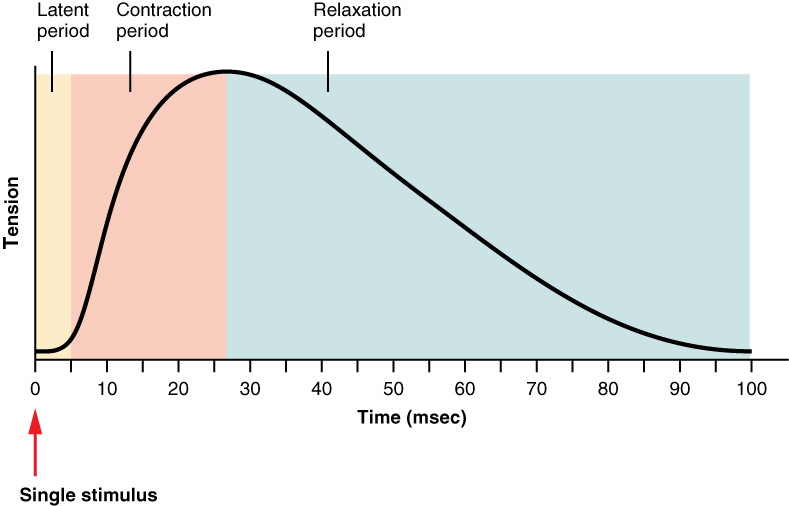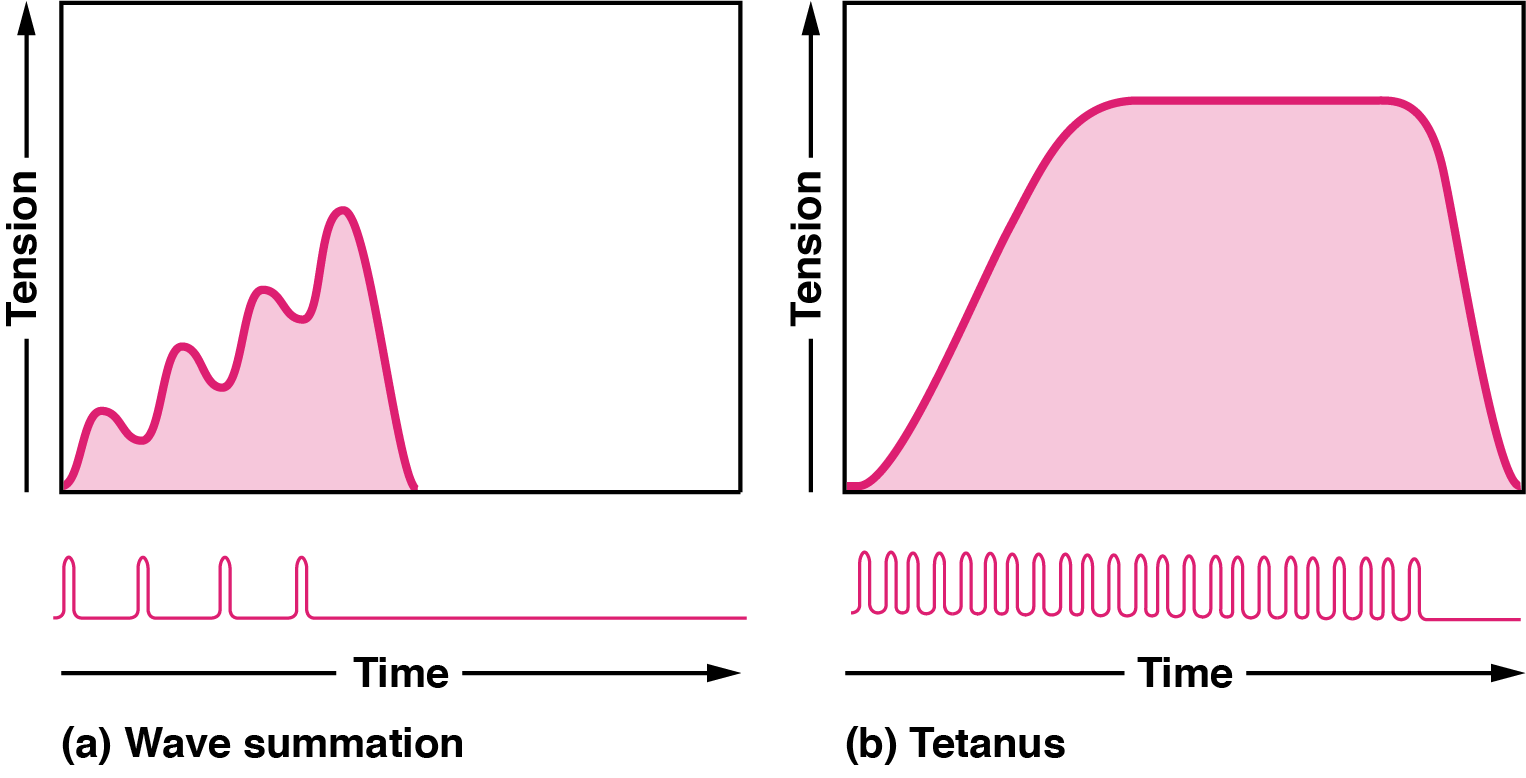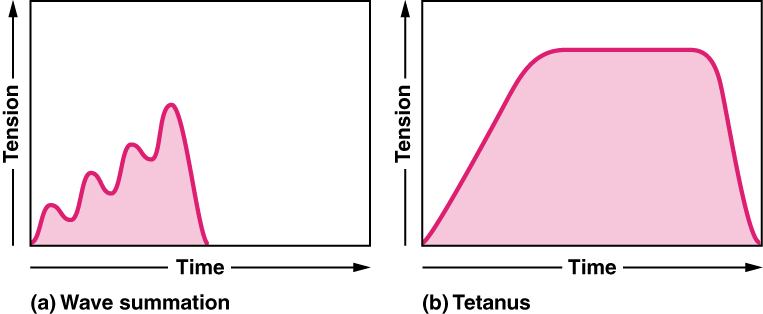
A single action potential from a motor neuron will produce a single contraction in the muscle fibers innervated by the motor neuron. This combination of a motor neuron and the muscle fibers it innervates is referred to as a motor unit. This isolated contraction is called a twitch. A twitch can last anywhere from a few milliseconds to 100 milliseconds, depending on the muscle fiber type. The tension produced by a single twitch can be measured by a myogram, an instrument that measures the amount of tension produced over time (Figure 38.1).
Three phases are recognized for a muscle twitch. The first phase is the latent period, during which the action potential is being propagated along the sarcolemma and Ca 2+ ions are released from the sarcoplasmic reticulum. This is the phase during which excitation and contraction are being coupled but contraction has yet to occur. The contraction phase occurs as the muscle generates increasing levels of tension; the Ca 2+ ions in the sarcoplasm have bound to troponin, tropomyosin has shifted away from actin-binding sites, cross-bridges have formed, and sarcomeres are actively shortening. The last phase is the relaxation phase, when tension decreases as Ca 2+ ions are pumped out of the sarcoplasm back into the sarcoplasmic reticulum, returning the muscle fibers to their resting state.

Although a person can experience a skeletal muscle “twitch,” a single twitch does not produce ‘useful’ activity in a living body. Instead, a rapid series of action potentials sent to the muscle fibers is necessary for a muscle contraction that can produce work. By varying the rate at which a motor neuron fires action potentials, the amount of tension generated by the innervated muscle fibers can be modified; this is called a graded muscle response.

A graded muscle response works as follows: if the fibers are stimulated while a previous twitch is still occurring, the second twitch will be stronger. This response is called wave summation, because the excitation-contraction coupling effects of successive motor neuron signaling is summed, or added together (Figure 38.2a). At the molecular level, summation occurs because the second stimulus triggers the release of more Ca 2+ ions, which become available to activate more cross-bridging while the muscle is still contracting from the first stimulus. Summation results in greater contraction of the motor unit.
If the frequency of motor neuron signaling increases, summation and subsequent muscle tension in the motor unit continues to rise until it reaches a peak point. The tension at this point is about three to four times greater than the tension of a single twitch, a state referred to as incomplete tetanus. During incomplete tetanus, the muscle goes through quick cycles of contraction followed by a short relaxation phase. If the stimulus frequency is so high that the relaxation phase disappears completely, contractions become continuous in a process called complete tetanus (Figure 38.2b).
During complete tetanus, the concentration of Ca 2+ ions in the sarcoplasm allows virtually all of the sarcomeres to form cross-bridges and shorten, so that a contraction can continue uninterrupted (until the muscle fatigues and can no longer produce tension).
When a skeletal muscle has been dormant for an extended period and then stimulated to contract, with all other things being equal, the initial contractions generate about one-half the force of later contractions. The muscle tension increases in a graded manner that to some looks like a set of stairs. This tension increase is called treppe, a condition where muscle contractions become more efficient. It’s also known as the “staircase effect” (Figure 38.3).

It is believed that treppe results from a higher concentration of Ca 2+ in the sarcoplasm resulting from the steady stream of signals from the motor neuron, increased contractile efficiency, and/or enzyme activity. It can only be maintained with adequate ATP.
Skeletal muscles are rarely completely relaxed, or flaccid. Even if a muscle is not producing movement, it is contracted a small amount to maintain its contractile proteins and produce muscle tone. The tension produced by muscle tone allows muscles to continually stabilize joints and maintain posture.
Muscle tone is accomplished by a complex interaction between the nervous system and skeletal muscles that results in the activation of a few motor units at a time, most likely in a cyclical manner. In this manner, muscles never fatigue completely, as some motor units are in a state of recovery while others are actively generating tension.
definitiona single motor neuron and all of the muscle fibers it innervates
× Close definitionone contraction in the muscle fibers innervated by a motor neuron, generated by a single action potential
× Close definitionan instrument measuring muscle activity, and therefore tension produced in a muscle over time
× Close definitionthe period of a muscle twitch prior to contraction when an action potential is propagated along the sarcolemma, causing calcium ion release from the sarcoplasmic reticulum
× Close definitionthe phase of a muscle twitch when a muscle generates tension, caused by the formation of cross-bridges and, as a result, the shortening of sarcomeres
× Close definitionthe phase of a muscle twitch when the tension produced by a muscle is decreased due to the absence of calcium ions in the sarcoplasm, and muscle fibers are reduced to their resting state
× Close definitionthe variation of action potentials produced by motor neurons, modifying the amount of tension produced by the innervated fibers
× Close definitionthe ability of muscle fibers to produce stronger contractions due to an additional stimulus from a motor neuron before a previous twitch has ended
× Close definitiona point of muscle contraction during which generated tension is at a peak point, and the muscle experiences quick cycles of contraction and short relaxation phases
× Close definitiona point of muscle contraction in which the frequency of a stimulus is so high that the relaxation phase of the muscle twitch disappears and the contraction phase is continuous
× Close definitionan increase in muscle tension in a graded manner
× Close definitioncontinuous, passive partial contraction of a muscle, helping to maintain posture and stabilize joints